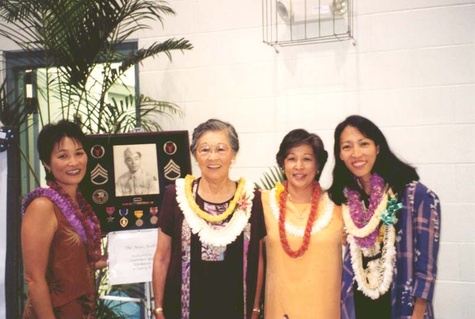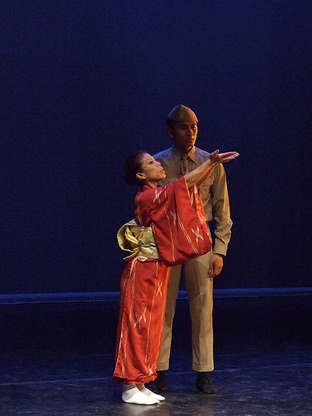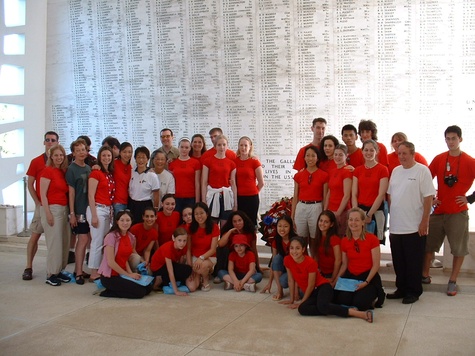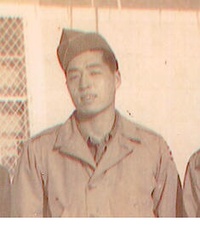The stories of the valiant all-Nisei 100th Infantry Battalion and the 442nd Infantry Regiment of World War II have been told in art forms ranging from haiku to the graphic novel. But choreographer Marla Hirokawa may well be the first person to bring the tale of discrimination, imprisonment, and battlefield glory to life in the form of a ballet.

"Nisei" Dancers: Terence Duncan, Deborah Li, Suzanne Lemmon, Lea Kramberg, Chi-Tsung Kuo; Photographer: Jonathan Fazio
Hirokawa, a Hawaiian-born Sansei and the artistic director of Covenant Ballet Theatre of Brooklyn and CBT Dance Academy, is readying her original ballet “Nisei” for its third public staging since its inception, as part of August’s New York City Fringe Festival. The ballet is based on the story of her late father, Lawrence Yoji Hirokawa, a soldier in the 100th Infantry Battalion. When the surprise attack on Pearl Harbor occurred on December 7, 1941, he had been drafted into the army and was stationed at Schofield Barracks in Oahu. He faced discrimination in basic training, lost an eye in battle at Monte Cassino, Italy, and returned home a hero, awarded the Purple Heart and Bronze Star medals.
Dreaming up and choreographing spectacles and finding ways to produce them on a shoestring are nothing new to Hirokawa. She has been training dancers and leading her company in Brooklyn for over 25 years now, and during that time Covenant has staged 10 of Hirokawa’s original ballets. When “Nisei” was first performed in Brooklyn in 2001, Hirokawa’s sister Laurie Hamano convinced her that she had to bring it to Hawaii to honor the Nisei veterans who were still alive. Hamano, Hirokawa, and other family and friends (most of whom had no experience as fundraisers) managed to collect $340,000 in donations to make the project—a three-week, 16-performance tour of the islands in July 2003—a reality.
Similar grit and perseverance carried Hirokawa through a more recent challenge. In the summer of 2012, when the loss of a major donor and the economic aftereffects of Superstorm Sandy threatened the future of the company and ballet school, loyal community members, students, and alumni helped raise nearly $20,000 to cover moving expense and keep Covenant alive.
This time around, Hirokawa and her company need $35,000 to stage “Nisei” as Hirokawa is determined to do it: with new orchestration, a live jazz band, and the addition of songs by Hawaiian ukulele master Jake Shimabukuro and singer/songwriter Harold Payne. Although this goal is far more modest than what was needed to stage the Hawaiian tour, it is in some ways a more daunting task, since the company has to vie for attention in the large and competitive New York City arts world. Through a fundanything.com campaign and private donations, Hirokawa has so far raised about a third of her goal, enough for the dancers’ salaries but not enough to pay for musicians and rehearsal space in the city; Covenant’s Brooklyn rehearsal space is too small to accommodate the full production. (Disclosure: after writing this Wall Street Journal article on Hirokawa and CBT, I have become a friend and supporter of the company.)
The ballet introduces the unnamed main character in conversation with his grandson, after which the story of his wartime exploits unfolds in the form of a flashback. As a young Nisei, he is shown with his traditional Japanese mother and two siblings, the racism they endure following Pearl Harbor, his progress through basic training (while his fellow soldiers are given guns, he is given a broom and KP duty), and eventually to the climactic battle on the Italian front. The action cuts to President Truman’s August 6, 1945 announcement of the dropping of the atom bomb on Hiroshima and the ballet ends with a Veteran’s Day parade back home.
For the Hawaii tour, veterans, including many Nisei veterans, were invited to take part in the parade scene that closes the ballet. “It was really beautiful,” recalls Hirokawa, adding, “I think we cried at every performance.” Each veteran was guided by a Girl Scout and announced by name to rousing applause as tears streamed down many of their faces. “They were already pretty old, some a little more feeble than others. But they would literally leave their canes in the wings in order to walk unhampered,” says Hirokawa.
The “Nisei” cast of approximately 25 is made up of professional dancers, a few who have come out of retirement for this production, as well as over a dozen young people ranging in age from eight to college-age. Many are either current Covenant Ballet Theatre Dance Academy students or alumni.
Hirokawa knew little about her parents’ wartime history until she began asking questions for a high school history research project. “Dad was very low-key,” she recalls. “He had tucked away all these vintage newspapers in the back of the closet from World War II,” she says, which he pulled out to show her. “We were the guinea pig battalion,” her father said of the 100th Infantry Battalion, sent in to the most dangerous, high-risk situations. After her father retired, her parents visited Europe and some of the battlegrounds he had fought on. “When they got to the top of Castle Hill at Monte Cassino, which his battalion had been ordered to take, she says, “He just started to curse, because he realized how vulnerable they were, like sitting ducks.”
Rather than becoming embittered, though, Hirokawa’s father was quietly proud of his contribution to the war effort, and developed a lifelong devotion to helping other veterans. He held various officer positions in Club 100, the civilian counterpart to the 100th Infantry Battalion, and, Hirokawa adds, “was very involved” in the DAV (Disabled American Veterans). She recalls a joyful and emotional reunion in Hawaii with the people of Bruyères, France, a village the combined 100th and 442nd Regimental Combat Team liberated from the Germans in 1944, after four years of occupation.
Musician Jake Shimabukuro, whose song honoring the Nisei vets, “Go For Broke,” is now a part of the ballet, grew up on the same street where the Honolulu Club 100 clubhouse was located. “They had this ice cold water fountain so when my friends and I rode our bikes around the block, we’d run in and get water,” he recalls. Years later, learning about the contribution of the Nisei soldiers of the 100th and 442nd, he was inspired to write “Go For Broke.” The title, he explains, comes from the motto of the regiment, itself a popular phrase that became part of Hawaiian Pidgin and was often heard when Nisei gambled on card games. Its meaning: “just go for it,” or “go all in.” Go For Broke is also the name of the foundation, educational center, and monument established by Nisei veterans in Los Angeles.
Hirokawa heard Shimabukuro’s instrumental song, fell in love with it, and tried without success to reach the musician to ask if she might use it for “Nisei.” Then her sister Laurie Hamano’s husband happened to win a private concert with Shimabukuro at a charity auction. Hamano says, “I’m not one to waste any time so after the concert I introduced myself and said, ‘You know, we’ve been trying to get in touch with you for a while. My sister wants to use your song in her ballet.’” Shimabukuro immediately gave Hamamoto his cell phone number to pass on to Hirokawa. “That was the whole purpose of the song,” he says, “to remind people…of the sacrifices [the Nisei soldiers] made, and how much we owe them.”
Hirokawa also managed to contact singer/songwriter Harold Payne, whose song, a tribute to Nisei vets titled “Quiet Heroes,” was another one that she wanted for her ballet. Payne grew up in Gardena, Calif. on a street with three 442nd veterans. Yet he didn’t know about their role in the war, or even about the World War II U.S. government concentration camps, until he was in his 20s; “They just didn’t talk about it,” he recalls. One day he overheard Harry Komatsu, who owned the gas station on the corner, mention going to Italy, where he and his fellow soldiers were to be honored. “That was when I learned the scope of their amazing contribution,” says Payne. When Hirokawa contacted him, Payne (who also wrote music for Cory Shiozaki’s documentary “The Manzanar Fishing Club”) says he was “honored to be able to contribute to getting their story told.”

Hirokawa family at benefit dinner for Nisei Project 2003: (L to R) Laurie Hamano, Marjorie Hirokawa, Avis Mortemore, Marla Hirokawa
Those who know Hirokawa speak with admiration of her drive to continue to teach and create her ballets despite considerable challenges. Hamano explains that her sister, the youngest of three girls, was born with both scoliosis and a congenital defect in her left hand. For four-and-a-half years, between the ages of 12 and 16, she wore a Milwaukee brace around her neck and torso for the scoliosis. “It was tough for her, growing up different, wearing this body brace all the time,” Hamano says. She and her sister Avis told their little sister, “If anybody bangs up on you, or says anything mean, we’ll go to school and beat them up,” recalls Hamano. “We are very tight, though we teased her to the nth degree. Growing up with those challenges created this steel mind of Marla’s.”
Hirokawa credits her perseverance to her unshakeable Christian faith and her internalization of the “gaman” attitude (to persevere, to persist with dignity) of her father and her family. “We kind of grew up in that culture where we don’t give up,” she explains. “My dad used to say, ‘Don’t be a quitter.’ He hated that.”
“Nisei” will be performed at the New York International Fringe Festival on:
August 9, 3:30 p.m. (followed by talk-back session)
August 12, 7 p.m.
August 13, 5:45 p.m.
August 15, 6:15 p.m.
August 16, 2 p.m.
Location:
14th Street Y
344 E 14th Street
New York, NY 10003
Click here for more information.
© 2014 Nancy Matsumoto








